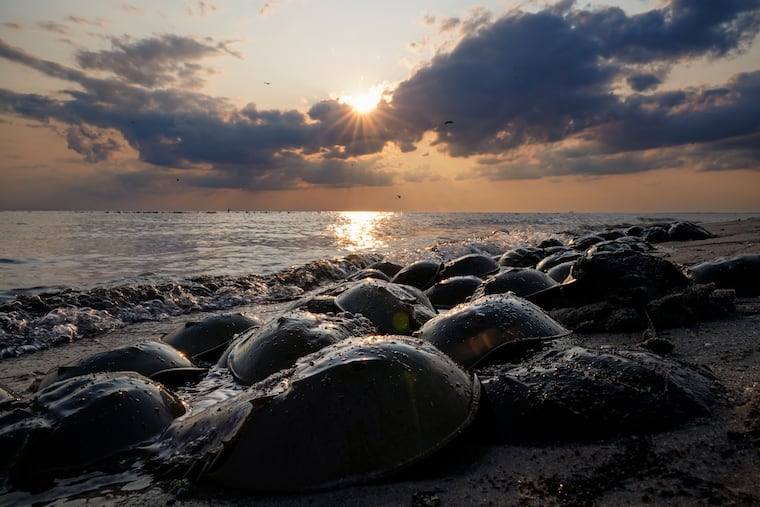Some good news for New Jersey’s ancient, dwindling horseshoe crab population
The highly prized blue blood of horseshoe crabs is collected by the biomedical industry as an agent that helps make vaccines safe.

The horseshoe crabs that clamber like armored warriors by the thousands each spring across Delaware Bay beaches in New Jersey trace back hundreds of millions of years to the age of dinosaurs.
While their numbers might look impressive to people who have witnessed the spectacle, horseshoe crabs are far below their modern peak marked in 1999.
One of the reasons for the decline of the ancient species: Their highly prized blue blood is collected by the biomedical industry to support production of a clotting agent that helps detect endotoxins in people, helping make vaccines and other medications safe. The agent allows for quick detection of infectious bacteria in drugs and medical devices.
Conservationist groups aligned with the nonprofit Horseshoe Crab Recovery Coalition rejoiced Friday when a major scientific organization, U.S. Pharmacopeia, issued new guidelines that pave the way for wider use of synthetic alternatives to horseshoe crab blood for biomedical testing.
Good news for horseshoe crabs is also a big plus for the federally threatened red knot that feasts each spring on the eggs of the crabs, which are not crustaceans but are closely related to spiders.
“A safe and expeditious transition from horseshoe crab blood to a synthetic alternative in the biomedical industry is an important step in protecting shorebirds, horseshoe crabs, and other wildlife,” Bethany Kraft, senior director of coastal and marine resilience at the National Audubon Society, said in a statement by the coalition.
The Rockville, Md.-based U.S. Pharmacopeia announced Friday that it had approved including non-animal-derived reagents for endotoxin testing formally next year in the National Formulary (USP-NF), which includes thousands of standards for medicines. The guidelines don’t prohibit use of Limulus amebocyte lysate (LAL), the clotting agent derived from horseshoe crabs.
But the addition gives pharmaceutical manufacturers the information needed to use synthetic chemical compounds.
Research has shown that up to 30% of horseshoe crabs tested can die as a result of the blood extraction, the Horseshoe Crab Recovery Coalition estimates, though specific numbers are hard to track. The blood has been valued at $15,000 a quart.
Horseshoe crabs are also harvested as bait and caught as bycatch and discarded by commercial fisheries. The majority of that harvest comes from the Delaware Bay.
For the Atlantic Coast, horseshoe crab landings peaked in 1999 at 2.6 million and have decreased since the late 1990s. Landings have remained under 1 million horseshoe crabs since 2003. In 2022, the latest year data is available, there were 573,633 horseshoe crabs, according to the 2024 Horseshoe Crab Stock Assessment Update by the Atlantic States Marine Fisheries Commission.
Though horseshoe crabs are native to the Mid-Atlantic, they are closely identified with the Delaware Bay, the part of the Delaware River estuary that borders New Jersey and Delaware before emptying into the Atlantic Ocean. Their eggs provide food for 11 migrating bird species such as the red knot, a federally threatened species.
The horseshoe crabs are not listed as endangered, but New Jersey implemented a moratorium in 2008 on harvesting them from May 1 through June 7 each year, with an exemption for biomedical use, provided they are released unharmed.
New Jersey Fish and Wildlife reports the Delaware Bay population may be recovering.
Delaware, Maryland, and Virginia allow harvesting but have set quotas.
The Horseshoe Crab Recovery Coalition, a group of 30 organizations, has urged for years that synthetics be used instead of horseshoe crab blood, and has briefed congressional staff members on the issue.
It’s unclear how big an impact the new guidelines will have on New Jersey’s horseshoe crab population, but state leaders backed them.
“I fully support U.S. Pharmacopeia’s new guidelines for synthetic alternatives to horseshoe crab blood for biomedical testing,” U.S. Rep. Frank Pallone Jr. (D., N.J.) said in a statement. “For years, I’ve been leading the charge in Congress to track horseshoe crabs, study coastal ecosystems, and modernize our biomedical testing guidelines.”